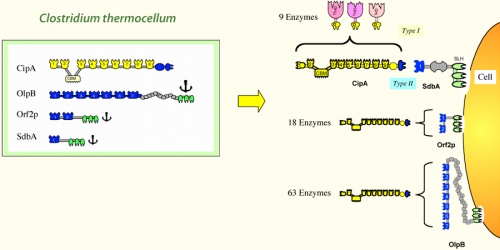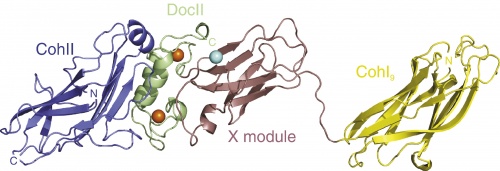CAZypedia celebrates the life of Senior Curator Emeritus Harry Gilbert, a true giant in the field, who passed away in September 2025.
CAZypedia needs your help!
We have many unassigned pages in need of Authors and Responsible Curators. See a page that's out-of-date and just needs a touch-up? - You are also welcome to become a CAZypedian. Here's how.
Scientists at all career stages, including students, are welcome to contribute.
Learn more about CAZypedia's misson here and in this article. Totally new to the CAZy classification? Read this first.
Difference between revisions of "Cellulosome"
Orly Alber (talk | contribs) |
Orly Alber (talk | contribs) |
||
| Line 30: | Line 30: | ||
To date, complex cellulosome systems have been described in different bacterial species ([http://www.weizmann.ac.il/Biological_Chemistry/scientist/Bayer/]). In these systems, more than one scaffoldin interlocks with each other in various ways to produce a complex cellulosome architecture. At least one type of scaffoldin serves as a primary scaffoldin that incorporates the enzymes directly into the cellulosome complex. In each species, another type of scaffoldin attaches the cellulosome complex to the cell surface via a specialized module or sequence, designed for this purpose. | To date, complex cellulosome systems have been described in different bacterial species ([http://www.weizmann.ac.il/Biological_Chemistry/scientist/Bayer/]). In these systems, more than one scaffoldin interlocks with each other in various ways to produce a complex cellulosome architecture. At least one type of scaffoldin serves as a primary scaffoldin that incorporates the enzymes directly into the cellulosome complex. In each species, another type of scaffoldin attaches the cellulosome complex to the cell surface via a specialized module or sequence, designed for this purpose. | ||
| − | [[File:Clostridium_cellulosome.jpg|500px|Schematic representation of ''C. Thermocellum'' cellulosome components]] | + | [[File:Clostridium_cellulosome.jpg|500px|thumb|Schematic representation of ''C. Thermocellum'' cellulosome components]] |
== Cohesin-dockerin interactions == | == Cohesin-dockerin interactions == | ||
| Line 40: | Line 40: | ||
One of the greatest efforts in the cellulosome research field is to understand the structure-function relationship in cellulosome assembly. Thus far, the crystallographic structure of only selected cohesins has been determined, including three different type-I cohesins, all of which share the typical jelly-roll topology that forms a flattened 9-stranded beta-sandwich. The structures of several type-II cohesins have also been determined. The type-II and type-III cohesins has the same jelly-roll topology as the type-I cohesins with several additional structural elements: an alpha-helix at the crown of the molecule (located in the loop connecting strands 6-7, and 8-9 for type-II and type-III, respectively), and two “beta-flaps” that provisionally disrupt the normal course of beta-strands 4 and 8 (Fig). | One of the greatest efforts in the cellulosome research field is to understand the structure-function relationship in cellulosome assembly. Thus far, the crystallographic structure of only selected cohesins has been determined, including three different type-I cohesins, all of which share the typical jelly-roll topology that forms a flattened 9-stranded beta-sandwich. The structures of several type-II cohesins have also been determined. The type-II and type-III cohesins has the same jelly-roll topology as the type-I cohesins with several additional structural elements: an alpha-helix at the crown of the molecule (located in the loop connecting strands 6-7, and 8-9 for type-II and type-III, respectively), and two “beta-flaps” that provisionally disrupt the normal course of beta-strands 4 and 8 (Fig). | ||
| − | [[File:Cohesinstr.jpg|500px|The crystal structure of type-I, II and III cohesin modules]] | + | [[File:Cohesinstr.jpg|500px|thumb|The crystal structure of type-I, II and III cohesin modules]] |
== History of discovery == | == History of discovery == | ||
Revision as of 04:18, 23 May 2010
This page is currently under construction. This means that the Responsible Curator has deemed that the page's content is not quite up to CAZypedia's standards for full public consumption. All information should be considered to be under revision and may be subject to major changes.
- Authors: ^^^Orly Alber^^^, ^^^Bareket Dassa^^^, and ^^^Ed Bayer^^^
- Responsible Curator: ^^^Ed Bayer^^^
Cellulosome complex
Cellulosome complexes are intricate multi-enzyme machines produced by many cellulolytic microorganisms. They are designed for efficient degradation of plant cell wall polysaccharides, notably cellulose — the most abundant organic polymer on Earth. The cellulosome consists of a multi-functional integrating subunit (called scaffoldin), responsible for organizing the various cellulolytic subunits (e.g., the enzymes) into the complex. Within a cellulosome, multiple endoglucanases, cellobiohydrolases, xylanases and other degradative enzymes work synergistically to attack heterogeneous, insoluble cellulose substrates. This is accomplished by the interaction of two complementary classes of module, located on the two separate types of interacting subunits, i.e., a cohesin module on the scaffoldin and a dockerin module on each enzymatic subunit. The high-affinity cohesin-dockerin interaction defines the cellulosome structure. Attachment of the cellulosome to its substrate is mediated by a scaffoldin-borne cellulose-binding module (CBM) that comprises part of the scaffoldin subunit. Much of our understanding of its catalytic components, architecture, and mechanisms of attachment to the bacterial cell and to cellulose, has been derived from the study of Clostridium thermocellum.
Cellulosome components:
- The scaffoldin subunit contains one or more cohesin modules connected to other types of functional modules. In a given scaffoldin, the latter types of modules may include a cellulose-specific carbohydrate-binding module (CBM), a dockerin, X modules of unknown function, an S-layer homology (SLH) module or a sortase anchoring motif. The arrangement of the modules on the scaffoldin subunit and the specificity of the cohesin(s) and/or dockerin for their modular counterpart dictate the overall architecture of the cellulosome. Several different types of scaffoldins have been described: the primary scaffoldins incorporate the various dockerin-bearing subunits directly into the cellulosome complex, adaptor scaffoldins increase the repertoire or number of components into the complex, and the anchoring scaffoldins attach the complex to the bacterial cell surface.
- Cohesin modules are the major building blocks of scaffoldins, which are responsible for organizing the cellulolytic subunits into the multi-enzyme complex.
- Dockerin modules anchors the catalytic enzymes to the scaffoldin. It displays internal two-fold symmetry, consisting of a duplicated F-hand motif (a calcium-binding loop preceding an a helix). The dockerin could also be found in the C terminal of scaffoldins.
Cellulosome systems
Bacterial cellulosomal systems can be categorized into two major types: simple cellulosome systems contain a single scaffoldin and complex cellulosome systems exhibit multiple types of interacting scaffoldins. The arrangement of the modules on the scaffoldin subunit and the specificity of the cohesin(s) and/or dockerin for their modular counterpart dictate the overall architecture of the cellulosome. Several different types of scaffoldins have been described: the primary scaffoldins incorporate the various dockerin-bearing subunits directly into the cellulosome complex, adaptor scaffoldins increase the repertoire or number of components into the complex, and the anchoring scaffoldins attach the complex to the bacterial cell surface.
Cellulosomes exist as extracellular complexes that are either attached to the cell wall of bacteria or free in solution, where the insoluble substrate can be broken down into soluble products and taken up by the cell. The large size and heterogeneity of cellulosomes from the best-characterized organisms (i.e., C. thermocellum, C. cellulolyticum, and C. cellulovorans) have greatly complicated efforts to probe cellulosome structure and function. Other cellulosome systems (such as those from Acetivibrio cellulolyticus and Ruminococcus flavefaciens) appear to be even more intricate.
The genes encoding for many important cellulosome subunits are organized in “enzyme-linked gene clusters” on the chromosome.
Simple Cellulosome Systems
In the simple cellulosome systems, the scaffoldins contain a single CBM, one or more X2 modules and numerous (5 to 9) cohesins. These scaffoldins are primary scaffoldins, which incorporate the dockerin-bearing enzymes into the complex. In several cases, the simple cellulosomes have been shown to be associated with the cell surface, but the molecular mechanism responsible for this is still unclear. The X2 module may play a role in attachment to the cell wall.
Complex Cellulosome Systems
To date, complex cellulosome systems have been described in different bacterial species ([1]). In these systems, more than one scaffoldin interlocks with each other in various ways to produce a complex cellulosome architecture. At least one type of scaffoldin serves as a primary scaffoldin that incorporates the enzymes directly into the cellulosome complex. In each species, another type of scaffoldin attaches the cellulosome complex to the cell surface via a specialized module or sequence, designed for this purpose.
Cohesin-dockerin interactions
Cohesin-dockerin interactions can be viewed as a kind of plug-and-socket in which the dockerin plugs into the cohesin socket1. In general, the interaction is inter-species and intra-species (type) specific, however some cross-reactivity has been found in a few cases. In terms of strength, the cohesin-dockerin interaction is one of the most potent protein-protein interactions known in nature, in most cases approaching the strength of high-affinity antigen-antibody interactions (Ka ~ 1011 M-1).
So far, cohesins have been phylogenetically distributed into three groups according to sequence homology; the type-I cohesin, the type-II cohesin and the recently discovered type-III cohesin. The dockerins that interact with each cohesin type are, by definition, of the same type.
Structural characterization of cellulosome components
One of the greatest efforts in the cellulosome research field is to understand the structure-function relationship in cellulosome assembly. Thus far, the crystallographic structure of only selected cohesins has been determined, including three different type-I cohesins, all of which share the typical jelly-roll topology that forms a flattened 9-stranded beta-sandwich. The structures of several type-II cohesins have also been determined. The type-II and type-III cohesins has the same jelly-roll topology as the type-I cohesins with several additional structural elements: an alpha-helix at the crown of the molecule (located in the loop connecting strands 6-7, and 8-9 for type-II and type-III, respectively), and two “beta-flaps” that provisionally disrupt the normal course of beta-strands 4 and 8 (Fig).
History of discovery
In the early 1980s, Profs. Raffi Lamed and Ed Bayer met at Tel Aviv University and commenced their work that led to the discovery of the cellulosome concept. Raffi approached Ed at the time with a description of how Clostridium thermocellum, an anaerobic thermophilic cellulolytic bacterium, bound very strongly to the cellulose substrate before it commences its degradation. They decided to study this phenomenon together.
At the time, they weren’t looking for enzymes or cellulosomes at all. They simply sought a ‘cellulose-binding factor’ or ‘CBF’ on the cell surface of the anaerobic thermophilic bacterium, Clostridium thermocellum, which they inferred would account for the observation that the bacterium attaches strongly to the insoluble cellulose substrate prior to its degradation. They employed a then unconventional experimental approach, in which they isolated an adherence-defective mutant of the bacterium and prepared a specific polyclonal antibody for detection of the functional component. Surprisingly, they isolated a very large multi-subunit supramolecular complex, instead of a small protein. Rather than discarding the uninvited material, they were alert enough to follow up this intriguing finding experimentally. A combination of biochemical, biophysical, immunochemical and ultrastructural techniques, followed by molecular biological verification, led to the definition and proof of the cellulosome concept. The birth of the discrete, multi-enzyme cellulosome complex was thus documented. Today, cellulosomes have been confirmed in several but not all cellulolytic bacteria. The cellulosome-producing strains exhibit surprising diversity in the composition and architecture of the component parts.
References
- Bayer EA, Belaich JP, Shoham Y, and Lamed R. (2004). The cellulosomes: multienzyme machines for degradation of plant cell wall polysaccharides. Annu Rev Microbiol. 2004;58:521-54. DOI:10.1146/annurev.micro.57.030502.091022 |
- Fontes CM and Gilbert HJ. (2010). Cellulosomes: highly efficient nanomachines designed to deconstruct plant cell wall complex carbohydrates. Annu Rev Biochem. 2010;79:655-81. DOI:10.1146/annurev-biochem-091208-085603 |
- Bayer EA, Lamed R, White BA, and Flint HJ. (2008). From cellulosomes to cellulosomics. Chem Rec. 2008;8(6):364-77. DOI:10.1002/tcr.20160 |
- Gilbert HJ (2007). Cellulosomes: microbial nanomachines that display plasticity in quaternary structure. Mol Microbiol. 2007;63(6):1568-76. DOI:10.1111/j.1365-2958.2007.05640.x |
- Doi RH and Kosugi A. (2004). Cellulosomes: plant-cell-wall-degrading enzyme complexes. Nat Rev Microbiol. 2004;2(7):541-51. DOI:10.1038/nrmicro925 |
- Demain AL, Newcomb M, and Wu JH. (2005). Cellulase, clostridia, and ethanol. Microbiol Mol Biol Rev. 2005;69(1):124-54. DOI:10.1128/MMBR.69.1.124-154.2005 |


